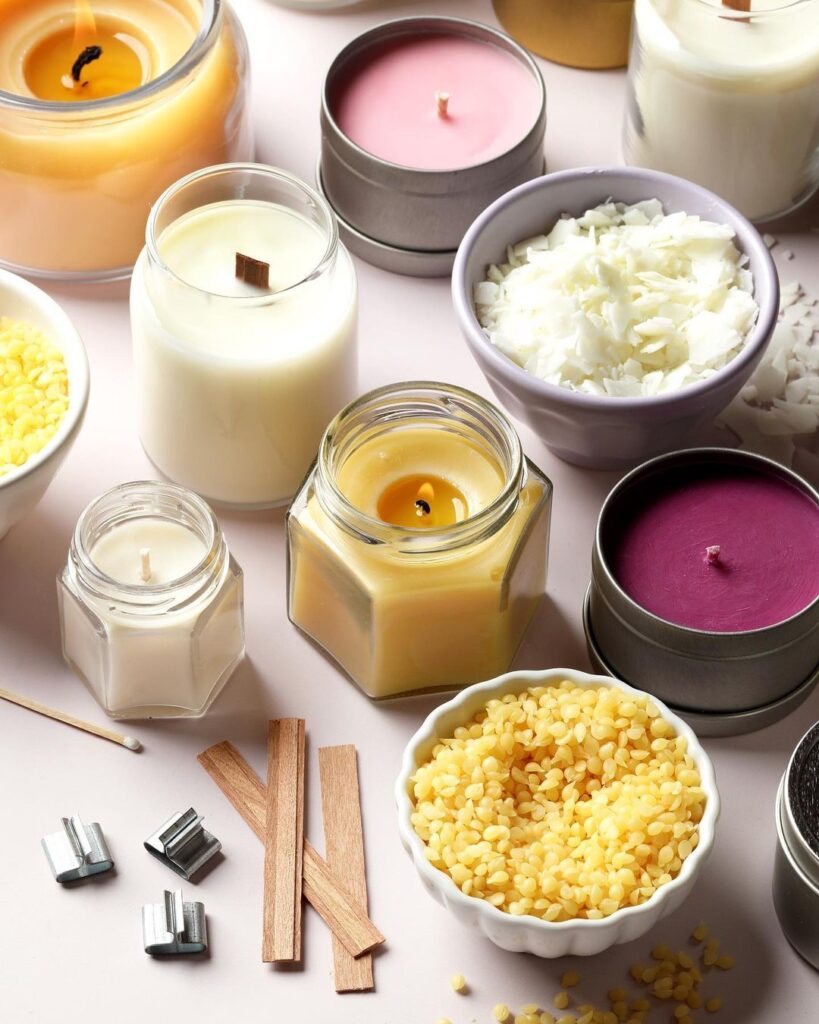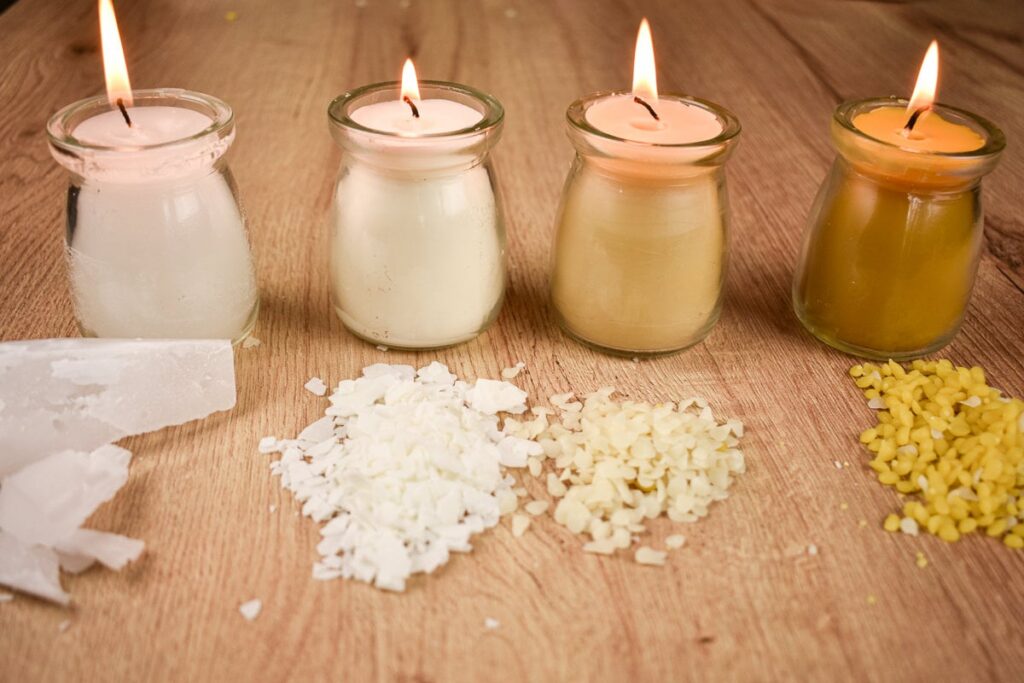When it comes to creating your own candles, choosing the right candle wax is essential. The type of wax you use can greatly affect the quality and performance of your candles. With so many options available, it’s important to understand the different types of candle wax and consider various factors before making a decision. In this article, we will explore the pros and cons of different types of candle wax, discuss the factors to consider when choosing candle wax, highlight safety precautions when working with candle wax, and troubleshoot common candle wax problems.
Understanding Different Types of Candle Wax
There are several types of candle wax available in the market, each with its own unique characteristics. Understanding the pros and cons of different types of candle wax can help you make an informed decision for your projects.
Paraffin Wax: Pros and Cons
Paraffin wax is one of the most popular choices for candle making. It is readily available, affordable, and easy to work with. Paraffin wax also offers excellent scent throw and has a long burn time. However, it is derived from petroleum, which raises concerns about its impact on the environment.

Soy Wax: Pros and Cons
Soy wax is a natural alternative to paraffin wax. Made from soybean oil, it is renewable and biodegradable. Soy wax candles produce less soot and have a cleaner burn compared to paraffin wax candles. Additionally, soy wax has a lower melting point, which means it can be poured at a lower temperature, reducing the risk of burns. On the downside, soy wax may not hold fragrance as well as paraffin wax and can be more expensive.
Beeswax: Pros and Cons
Beeswax is another natural option for candle making. It has a beautiful natural scent and burns cleanly. Beeswax candles have a longer burn time and emit negative ions that help purify the air. However, beeswax can be more expensive than other waxes and may require special handling due to its high melting point. Learn more about purify the air at https://ehs.umass.edu/air-purifiers-fact-sheet
Palm Wax: Pros and Cons
Palm wax is a sustainable choice for candle making. It is derived from palm fruit oil and is known for its unique crystalline appearance. Palm wax has a high melting point, which makes it suitable for creating decorative candles. However, the environmental impact of palm oil production has raised concerns among some candle makers.
Aside from these commonly used candle waxes, there are a few other options worth exploring. One such option is bayberry wax, which is derived from the berries of the bayberry shrub. Bayberry wax has a pleasant natural scent and a beautiful green color. However, it can be quite expensive and is not as readily available as other waxes.
Another interesting choice is coconut wax, which is made from the meat of coconuts. Coconut wax has a creamy texture and a subtle tropical scent. It has a clean burn and good scent throw, making it a popular choice among candle enthusiasts. However, coconut wax can be more expensive than other waxes and may require special handling due to its low melting point.
As you can see, there are numerous options when it comes to candle wax. Each type has its own unique qualities and considerations. Whether you prioritize affordability, sustainability, or fragrance throw, there is a candle wax out there that will meet your needs. So go ahead, explore the world of candle making and find the perfect wax for your next project!
Factors to Consider When Choosing Candle Wax
When choosing candle wax, consider the following factors:
The Purpose of Your Candle Project
Think about the purpose of your candles. Are you creating them for personal use or as gifts? Different waxes may be better suited for different purposes. For example, if you want long-lasting candles for special occasions, paraffin wax or beeswax might be the better choice. If you prefer a natural option, soy or beeswax could be more suitable.
Furthermore, consider the design and style of the candles you wish to create. Certain waxes may be better for achieving specific textures or colors. For instance, soy wax is known for its ability to hold color and scent well, making it ideal for vibrant and fragrant candles. On the other hand, beeswax has a natural golden hue that can add a warm and inviting aesthetic to your candles. Click here to learn more about natural golden.
Your Budget Considerations
Consider your budget when selecting candle wax. Paraffin wax is generally the most affordable option, while soy and beeswax tend to be pricier. Remember to factor in the cost of other materials you’ll need for candle making, such as wicks and fragrance oils.
Additionally, think about the quantity of candles you plan to make. Some waxes may be more cost-effective when purchased in bulk, helping you save money in the long run if you are planning a large candle-making project. Be sure to calculate the overall expenses to determine the most economical choice for your specific needs.
Environmental Impact
If sustainability is important to you, choose a wax that aligns with your values. Soy and beeswax are renewable and biodegradable options, while paraffin and palm wax have drawbacks in terms of their petroleum-based or production methods.
Moreover, delve into the sourcing practices of the wax manufacturers. Look for certifications such as organic, non-GMO, or sustainably sourced to ensure that the wax you choose meets your environmental standards. By selecting eco-friendly waxes, you not only support sustainable practices but also contribute to reducing your carbon footprint.
Scent Throw and Burn Time
Consider the scent throw and burn time you desire for your candles. Some waxes, like paraffin, have excellent scent throw and long burn times, while others may have different characteristics. Keep in mind that fragrance oils and wick choices also impact scent throw and burn time.
Experiment with different wax types and wick sizes to find the right balance between scent throw and burn time for your candles. Be mindful of the environment in which the candles will be used; larger rooms may require waxes with stronger scent throws, while smaller spaces may benefit from longer burn times. Finding the perfect combination will ensure that your candles create the desired ambiance and olfactory experience.
Safety Precautions When Working with Candle Wax
Working with candle wax involves handling hot materials, so it’s important to take proper safety precautions.
Before diving into the world of candle making, it’s crucial to understand the potential hazards associated with working with hot wax. Not only can hot wax cause burns, but it can also lead to fires if not handled properly. By following some simple safety guidelines, you can enjoy the art of candle making while keeping yourself and your surroundings safe.
Handling Hot Wax Safely
Always use heat-resistant gloves and protective eyewear when handling hot wax. Be cautious of the temperature and never leave melting wax unattended. It’s also advisable to have a dedicated workspace free from clutter to minimize the risk of accidents. Keep a fire extinguisher nearby and know how to use it in case of emergencies.
When working with hot wax, it’s essential to have a plan in case of accidental spills or burns. Have a first aid kit readily available with supplies to treat minor burns. Additionally, familiarize yourself with the proper procedures for extinguishing different types of fires to ensure you can respond quickly and effectively in case of an emergency.
Proper Ventilation and Clean Up
Ensure you have proper ventilation in your workspace to prevent inhalation of fumes. Wax fumes can be harmful if inhaled in large quantities, so working in a well-ventilated area or using a fume hood is recommended. When cleaning up spilled wax, wait for it to cool and harden before using a scraper or a blunt knife to remove it. Avoid pouring melted wax down the drain, as it can solidify and cause clogs.
Proper ventilation is not only important for your health but also for the quality of your candles. Adequate airflow helps the candles cool evenly and prevents the formation of soot. Additionally, maintaining a clean workspace free from dust and debris can help improve the overall quality of your candle products.
Safe Storage of Candle Wax
Store your candle wax in a dry, cool place away from direct sunlight and heat sources. Make sure the containers are tightly sealed to prevent moisture absorption and maintain the quality of the wax. It’s also a good idea to label your wax containers with the date of purchase to ensure you use the oldest wax first, following the principle of “first in, first out.”
By following these safety precautions and guidelines, you can enjoy the art of candle making while minimizing the risks associated with working with hot wax. Remember, safety always comes first, so take the necessary steps to protect yourself and those around you when indulging in your candle making hobby.
Troubleshooting Common Candle Wax Problems
Even with proper precautions, candle making can sometimes present challenges. Here are some common candle wax problems and how to troubleshoot them:
Preventing Wax Frosting
If your candles develop a white, powdery appearance called wax frosting, it could be due to temperature fluctuations during cooling. To prevent this, try pouring your wax at a lower temperature, preheat your containers, or use a heat gun to smooth the surface after pouring.
Solving Scent Issues
If your candles don’t seem to have a strong scent or the fragrance dissipates quickly, consider using a higher concentration of fragrance oil or using a different type of wax that holds fragrance better. Also, ensure your wick size matches the diameter of your candle to ensure a consistent burn and scent throw.

Fixing Burn Problems
If your candles have uneven or tunneling burns, trim the wick to the appropriate length before each use to ensure a clean and even burn. Avoid drafts that can cause the flame to flicker, leading to an uneven burn. Using a wick trimmer can help maintain the proper length for an optimal burn.
Now, let’s delve a little deeper into the world of candle making troubleshooting. One common issue that candle makers encounter is sinkholes. Sinkholes are depressions or holes that form in the center of the candle as it cools. This can happen when the wax contracts and pulls away from the sides of the container, leaving a void in the middle. To prevent sinkholes, ensure that you pour your wax at the correct temperature and avoid overcooling. Additionally, gently tapping the container after pouring can help release any air bubbles that may contribute to sinkholes.
Another challenge that candle makers face is wet spots. Wet spots are areas on the container candle where the wax pulls away from the glass, creating an unsightly appearance. This can happen due to temperature fluctuations during cooling or improper adhesion of the wax to the container. To minimize wet spots, try warming the container slightly before pouring the wax to create a better bond. Additionally, avoid exposing the finished candle to extreme temperature changes, as this can cause the wax to contract and create wet spots.
Choosing the right candle wax is crucial for achieving the desired results in your candle-making projects. Consider the pros and cons of different types of candle wax, evaluate various factors such as burn time and scent throw, take safety precautions, and troubleshoot any problems that may arise. With the right wax and knowledge, you can create beautiful, long-lasting candles that bring warmth and fragrance to any space.
Learn more about Wholesale Candle Jars in Sydney and Melbourne on https://wonderandcharm.com/wholesale-candle-jars-in-sydney-and-melbourne-top-suppliers/

